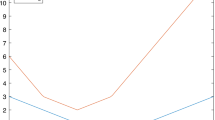Abstract
Staircase structured linear programs arise naturally in the study of engineering economic systems. One general approach to solving such LP's is the technique of nested decomposition of the primal or dual problem. The research described in this paper proposes a revised decomposition algorithm that incorporates knowledge of the structure of the staircase basis in forming the decomposed linear programs. Column proposals from the revised subproblems are shown to achieve maximum penetration against the master problem basis. The proposed algorithm resorts to the regular Dantzig-Wolfe subproblem to test for optimality. The algorithm is shown to be finite and is compared to the Abrahamson-Wittrock algorithm. Computational results indicate substantial improvement over the Dantzig-Wolfe algorithm in most cases. A numerical example of the algorithm is provide in the appendix.
Similar content being viewed by others
References
P.G. Abrahamson, “A nested decomposition approach for solving staircase-structured linear programs,” in: G.B. Dantzig, M.A.H. Dempster and M. Kallio, eds.,Large-scale Linear Programming: Proceedings of a HASA workshop (International Institute for Applied Systems Analysis, Laxenburg, 1981) pp. 367–381.
J.F. Benders, “Partitioning procedures for solving mixed-variables programming problems,”Numerische Mathematik 4 (1962) 238–252.
R.H. Cobb and J. Cord, “Decomposition approaches for solving linked problems,” in: H.W. Kuhn, ed.,Proceedings of the Princeton Symposium on Mathematical Programming (Princeton University Press, Princeton, NJ, 1970) pp. 37–49.
G.B. Dantzing,Linear Programming and Extensions (Princeton University Press, Princeton, NJ, 1963).
G.B. Dantzig, “Time-staged linear programs,” Technical Report SOL 80-28, Systems Optimization Laboratory, Department of Operations Research, Stanford University (Stanford, CA, 1980).
G.B. Dantzig and P. Wolfe, “Decomposition principle for linear programs,”Operations Research 8 (1960) 101–110.
G.B. Dantzig and P. Wolfe, “The decomposition algorithm for linear programs,”Econometrica 29 (1961) 767–778.
R. Fourer, “Sparse Gaussian elimination of staircase linear systems,” Technical Report SOL 79-17, Systems Optimization Laboratory, Department of Operations Research, Stanford University (Stanford, CA, 1979).
R. Fourer, “Solving staircase linear programs by the simplex method, 1: Inversion,”Mathematical Programming 23 (1982) 274–313.
R. Fourer, “Solving staircase linear programs by the simplex method, 2: Pricing,”Mathematical Programming 25 (1983) 251–292.
A.M. Geoffrion, “Elements of large-scale mathematical programming, part I: Concepts”,Management Science 16 (1970) 653–675.
C.R. Glassey, “Dynamic linear programs for production scheduling,”Operations Research 19 (1971) 45–56.
C.R. Glassey, “Nested decomposition and multi-stage linear programs,”Management Science 20 (1973) 282–292.
J.K. Ho and E. Loute, “A comparative study of two methods for staircase linear programs,”Transactions on Mathematical Software, ACM 6 (1980) 17–30.
J.K. Ho and E. Loute, “A set of staircase linear programming test problems,”Mathematical Programming 20 (1981) 245–250.
J.K. Ho and E. Loute, “An advanced implementation of the Dantzig-Wolfe decomposition algorithm for linear programming,”Mathematical Programming 20 (1981) 303–326.
J.K. Ho and E. Loute, “Computational experience with advanced implementation of decomposition algorithms for linear programming,”Mathematical Programming 27 (1983) 283–290.
J.K. Ho and A.S. Manne, “Nested decomposition for dynamic models,”Mathematical Programming 6 (1974) 121–140.
M. Kallio and E.L. Porteus, “Decomposition of arborescent linear programs,”Mathematical Programming 13 (1973) 348–356.
L.S. Lasdon,Optimization Theory for Large Systems (Macmillan, New York, 1970).
D.F. Lynch, “A nested decomposition algorithm with surrogate rows for staircase structured linear programs,” M.S. thesis, School of Operations Research and Industrial Engineering, Cornell University (Ithaca, NY 1983).
D.F. Lynch, “The guided decomposition algorithm for linear programs,” Ph.D. thesis, School of Operations Research and Industrial Engineering, Cornell University (Ithaca, NY, 1984).
A.S. Manne, “Sufficient conditions for optimality in an infinite horizon development plan,”Econometrica 38 (1970) 18–38.
B.A. Murtagh and M.A. Saunders, “MINOS user's guide,” Technical Report SOL 77-9, Systems Optimization Laboratory, Department of Operations Research, Stanford University (Stanford, CA, 1977).
G.L. Nemhauser, “Decomposition of linear programs by dynamic programming,”Naval Research Logistics Quarterly 11 (1974) 191–196.
P.V. Preckel, “Modules for use with MINOS/AUGMENTED in solving sequences of mathematical programs,” Technical Report SOL 80-15, Systems Optimization Laboratory, Department of Operations Research, Stanford University (Stanford, CA, 1980).
M.A. Saunders, “MINOS system manual,” Technical Report SOL 77-31, Systems Optimization Laboratory, Department of Operations Research, Stanford University (Stanford, CA, 1977).
R.M. van Slyk and R. Wets, “L-shaped linear programs with applications to optimal control and stochastic programming,”SIAM Journal of Applied Mathematics 17 (1969) 638–663.
R.J. Wittrock, “Advances in a nested decomposition algorithm for solving staircase linear programs,” Technical Report SOL 83-2, Systems Optimization Laboratory, Department of Operations Research, Stanford University (Stanford, CA, 1983).
Author information
Authors and Affiliations
Additional information
This research was supported by National Science Foundation grant ECS-8106455 to Cornell University.
Rights and permissions
About this article
Cite this article
Jackson, P.L., Lynch, D.F. Revised dantzig-wolfe decomposition for staircase-structured linear programs. Mathematical Programming 39, 157–179 (1987). https://doi.org/10.1007/BF02592950
Received:
Revised:
Published:
Issue Date:
DOI: https://doi.org/10.1007/BF02592950




